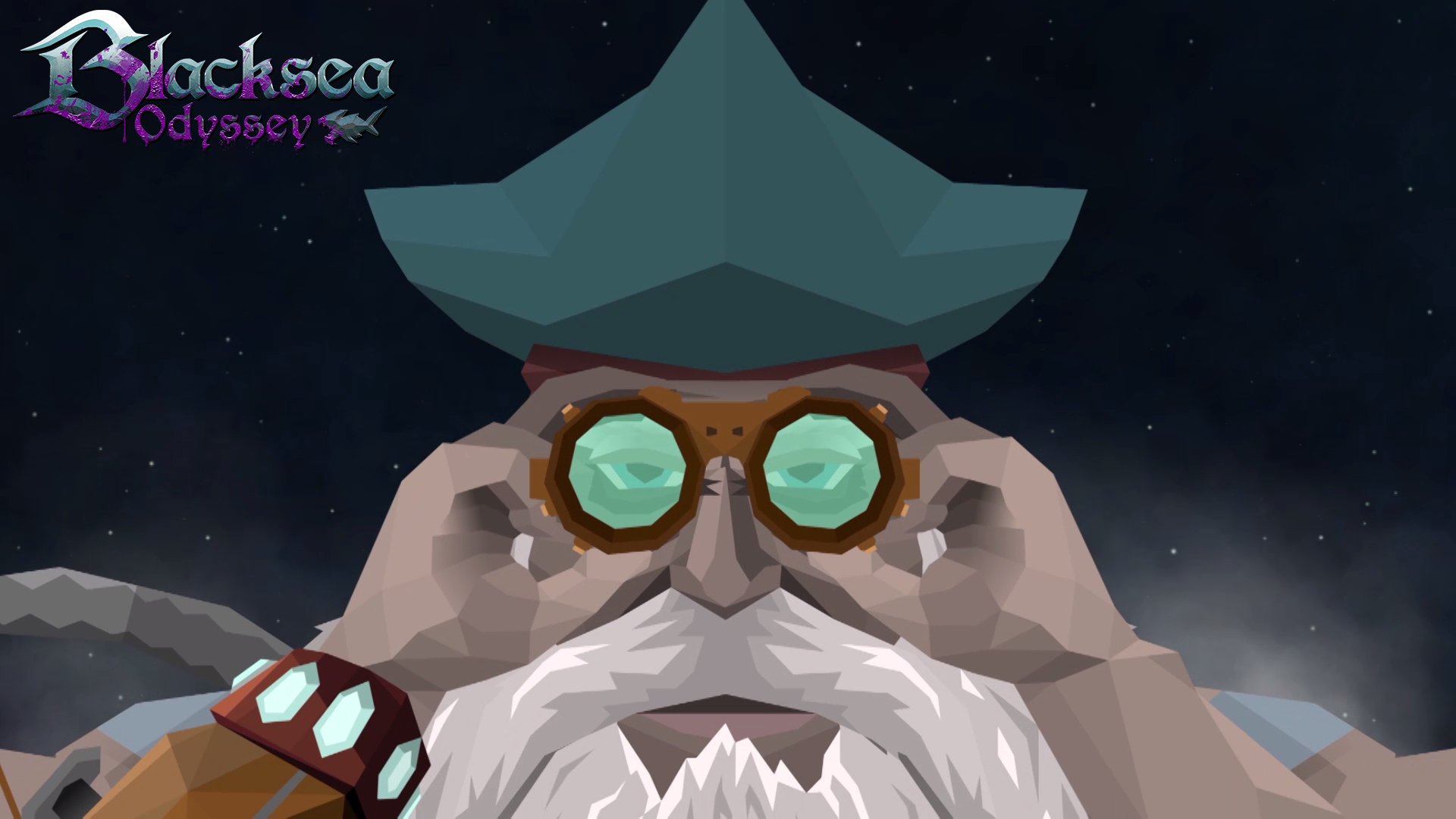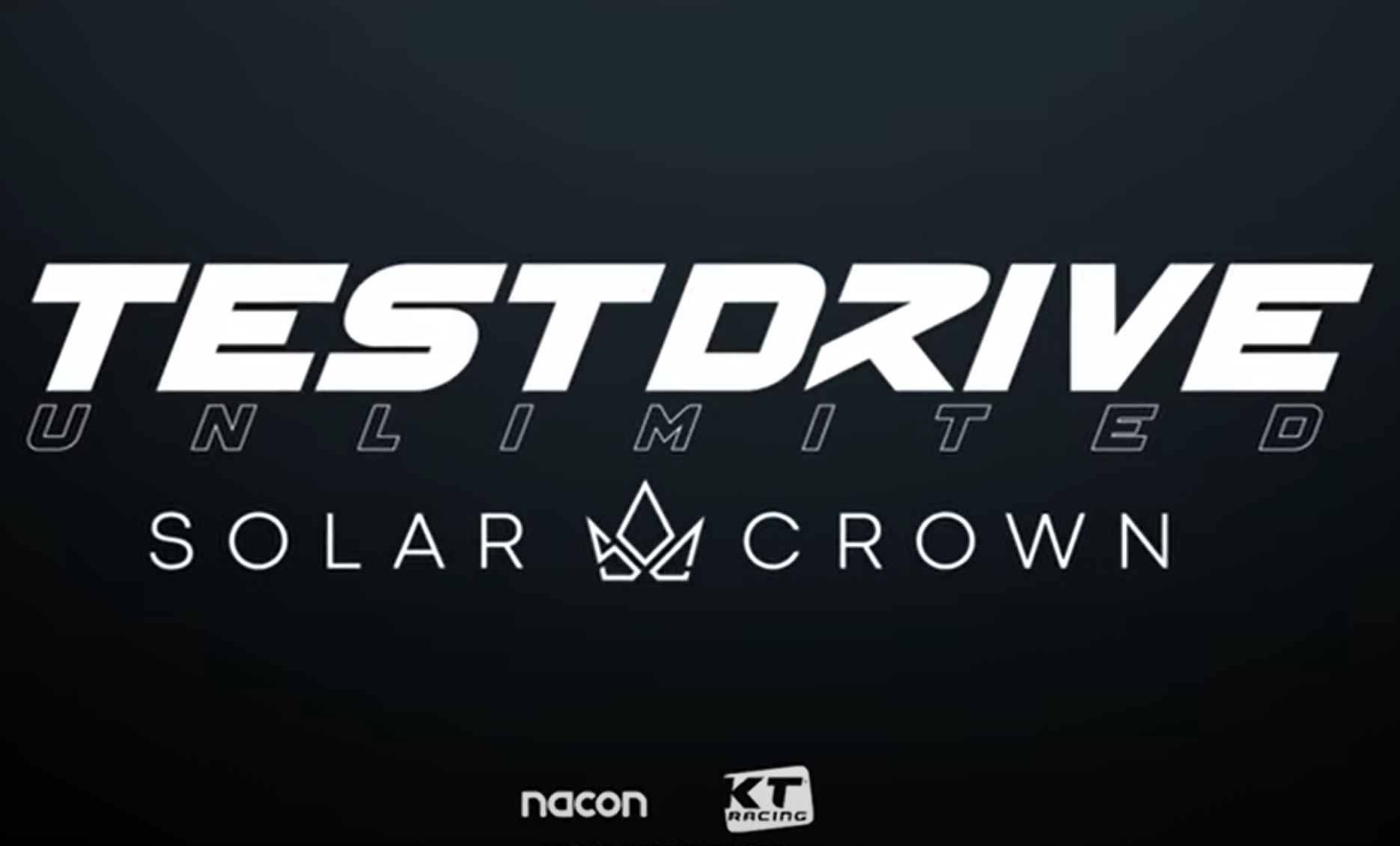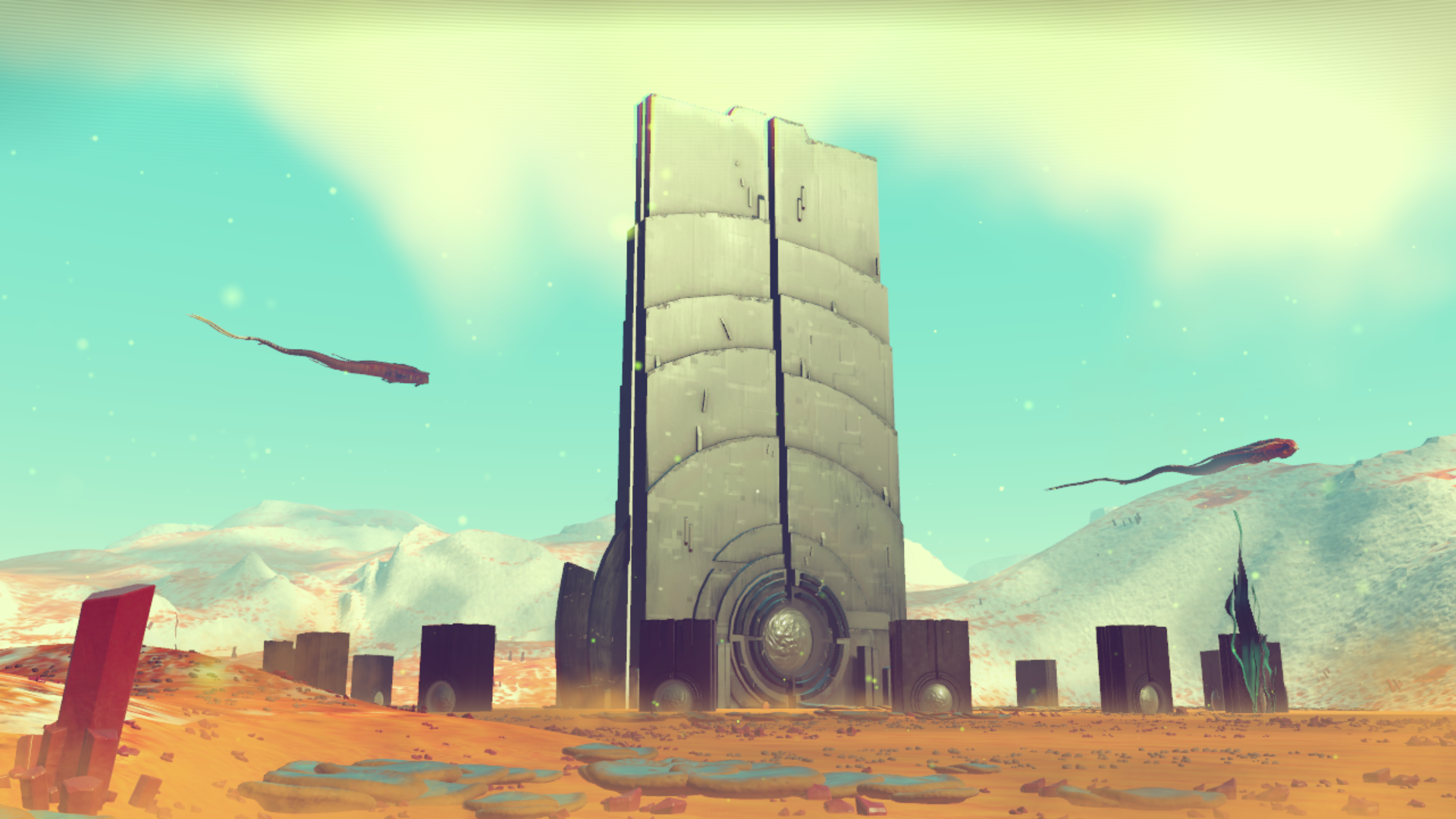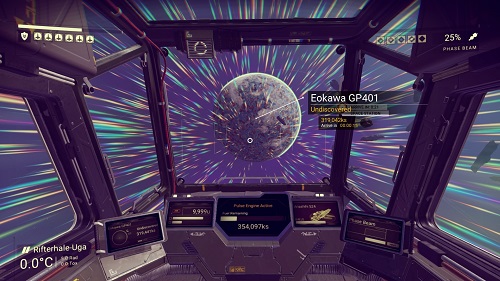
In December 2013, an indie developer by the name of Hello Games took the world by storm with the first teaser trailer for their new sci-fi IP, No Man’s Sky. At that point known for the Joe Danger series, No Man’s Sky looked to be a complete departure from their previous work, with the potential to be a groundbreaking experience. Quintillions of planets, uncountable numbers of solar systems, procedurally generated planets with flora and fauna, multiple alien races and a knowledge based language system, and more, promised a scope that hadn’t been seen in a game before. The levels of hype around No Man’s Sky hit levels beyond that seen for most AAA titles, let alone for a new IP from a 13-person studio. The hype meant that No Man’s Sky had an incredibly high level of expectation to meet. Unfortunately, as of its release, it has failed to meet it.
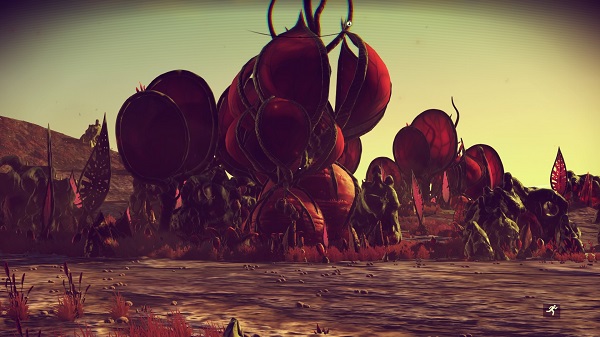
The procedural nature of No Man’s Sky is apparent right from the beginning of the game, as you awaken on an alien planet after seemingly crash landing. I say seemingly, because the sparse nature of the narrative in No Man’s Sky doesn’t explain much as you play through the game. After awakening, you are tasked with finding the resources needed to repair your crashed ship. This is told to you through a small pop-up that appears in the bottom right hand corner of your screen. That pop-up is No Man’s Sky’s equivalent to the quest systems found in MMOs like World of Warcraft, except that you have no control over when it pops up and goes away to remind you of your quest. It might seem like a small thing, but only being able to see your goal when the game decides it’s time to flash it at you and not being able to hide it when all you want to do is take some screenshots is frustrating.
After the almighty pop-up has advised you of what you need to find to repair your ship, as well as how to scan and mine for resources with your ‘multitool’, it’s all up to you. You’ll have to work out how to craft, how to power up your life support systems and shields, and how to recharge your multitool while in the field. None of these are prohibitively hard to work out, and only require opening the menu, hovering over the appropriate section and selecting the appropriate option. This sets the tone for No Man’s Sky as a whole, as Hello Games have taken an extremely hands off approach in the overall narrative and system design. What this polarising decision means is that you’ll need to work hard to make discoveries, which will either make you appreciate them all the more, or confuse and frustrate you.
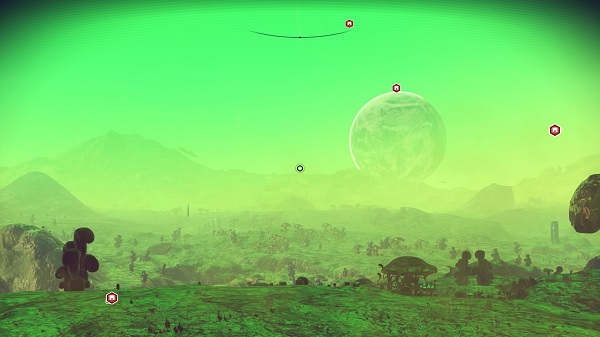
Personally, I was looking forward to No Man’s Sky’s promise to explore truly alien worlds and galaxies. I threw myself into No Man’s Sky with gusto, trawling planets to discover everything that I could, but quickly realised that there wasn’t the variety that I had expected. I began to see similarities between plants and creatures from solar system to solar system. There is definitely some variety, but you begin to recognise the parts the procedural engine has picked and put together. This is especially true when speaking of plants that provide resources like zinc and platinum, with the exact same flowers being present in every solar system, but with different names. When discovering plants and creatures, you get a small credit bonus and then a further bonus once you upload that discovery. Unless you can find and discover absolutely every plant and creature on a planet, the credit bonuses you get are paltry at best, and with the incredible size of each planet it’s rarely feasible to spend the time necessary to discover everything, leaving little incentive to do so.
Creatures fare a bit better in the grand scheme of things, with a seemingly larger variety of procedural components and a more interactive nature that helps keep them fresh and interesting. Creatures have a variety of different AI natures, with some being passive, some aggressive, some timid and many more. However, these AIs aren’t always consistent, with some creatures that are listed as passive attacking you and some aggressive creatures that actually leave you alone. It can get a tad frustrating when you get close to something that was listed as passive or timid only for it to attack you without warning. Another frustration comes in the form of trying to discover and tag birds. During my time with No Man’s Sky I’ve found it nearly impossible to get enough of a look at birds with my scanner to be able to analyse and discover them.
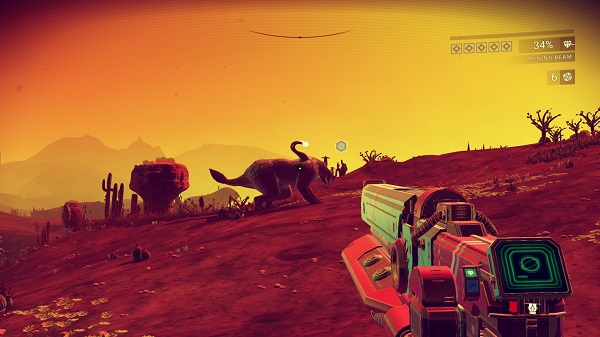
Other planetary tasks are a little more fun. Mining, which is really one of the largest focuses of No Man’s Sky, feels incredibly tactile – I’ve always enjoyed the mining in Minecraft, but there is something so much more fulfilling about blasting holes in the side of giant mounds of gold and watching a tree disintegrate into carbon. Mining is the true lifeblood of No Man’s Sky, as it’s necessary to power the other aspects of the game. You need plutonium to fuel your ship’s launch thrusters, which in turn will take you to new Drop Pods or Shelters, and you’ll need both plutonium and carbon to fuel your life support systems and keep breathing. Mining is both satisfying and hooks into the overall ecosystem of No Man’s Sky in a rewarding way.
The same can be said of the language system, which is my personal favourite part of No Man’s Sky. Hello Games have created a language for each of the game’s races of aliens that you will need to learn. Unless you make the effort to learn each alien race’s language, you won’t get very far in conversations with them, especially when you need to choose the correct response. There are a few different ways to learn the languages of No Man’s Sky, with most of them providing a single word at a time. The most rewarding way is through No Man’s Sky’s monoliths. Monoliths are large stone structures that provide you with a choice and subsequent consequence. After activating a monolith you are presented with a small text description of what is happening, like a scaly hand bursting out and grabbing you, a range of choices of what to do in the situation and a short sentence in the alien language to guide your choice. Without understanding much of the alien language it’s easy to make the wrong decision in these situations, however as you learn more they become easier to complete. This situation, along with understanding more of what aliens say to you, is the perfect example of an organic system that grows as you progress and is visibly and mentally rewarding. Seeing a sentence where you know more words than not is incredibly exhilarating and probably what I would consider to be the best envisioned and most complete part of No Man’s Sky.
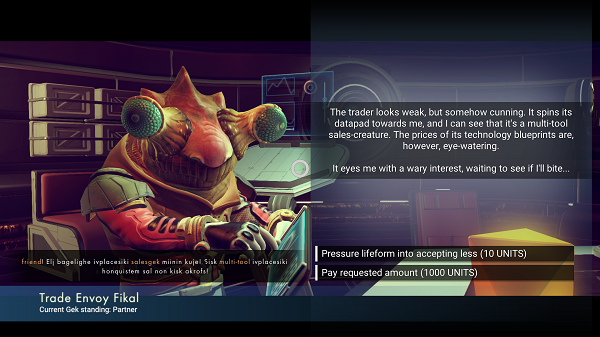
Throughout all of this there are two constants that are ever present, the weather and sentinels. The sentinels are a race of robots that guard and protect every planet in No Man’s Sky from space cowboys such as yourself. How aggressively they perform this duty changes from planet to planet, with some sentinels happy to leave you alone unless they actively catch you destroying things as they scan you and others hell bent on your destruction. My most exhilarating experience in No Man’s Sky has been running through a planet with high security, where sentinels will attack you on sight. However, while I ran in terror from the hordes of sentinels attacking me, I came across more knowledge stones, monoliths, upgrades and valuable items than I had on any planet before. Weighing up the risks vs rewards on the fly as I explored was extremely satisfying.
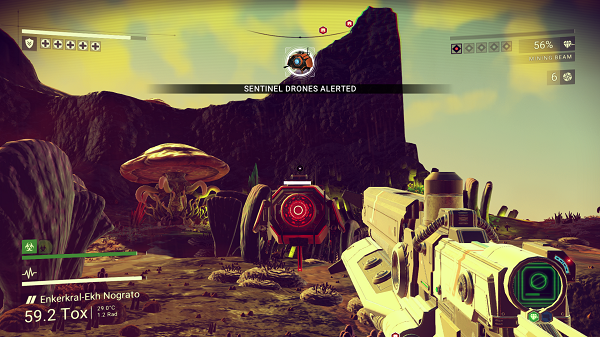
The weather in No Man’s Sky is another thing that can be a constant threat to your exploration. Extreme heat, cold, toxic rain and radiation can all cause you problems, but while the weather works its way through your shields, you can replenish them using various metals you find on the planet, like zinc and titanium, which aren’t always easy to find. Once you have a grenade attachment for your multitool, however, the weather in No Man’s Sky becomes meaningless. All you need to do is blow a small hole in the ground or the side of a mountain and you’re out of the weather. Want to keep mining that mountain of gold you found? Just create an angled hole next to it using grenades and you can keep mining while your shields recharge within seconds. It’s a system whose threat is easily avoided and feels harmless within an hour of playing No Man’s Sky.
The weak weather system isn’t the only issue with ground exploration either, with the lack of a map and distinction between discovered points being an issue, as well as the lack of interactivity between your ship and the planet. In No Man’s Sky you can activate search beacons which will unlock a point of interest for you to go to, be it a shelter, monolith or other. The only issue is that there is no distinction on your screen between a place you have already been to and a point of interest that you still need to see. While this isn’t an issue if you head straight to the point of interest, it can get frustrating if you leave it for a bit and suddenly have to remember which shelter was the one you haven’t been to.
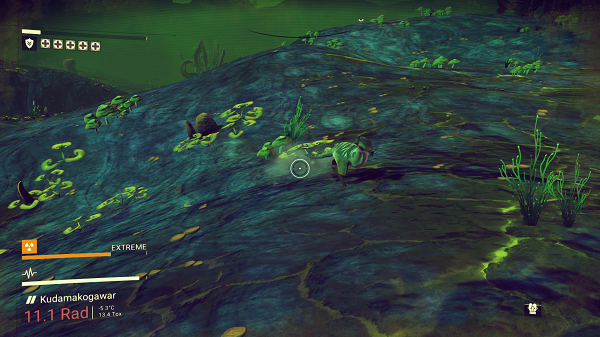
Now that your current planet is empty, it’s time to fly toward the stars. Exiting the atmosphere is an experience in itself, as you climb away from the planet through the clouds and into the darkness of space. There is less to do out here; resources can be collected from asteroids littering the void. Larger asteroids, which I tend to call mining asteroids, can contain a number of different resources, normally different metals, and can quickly fill your ships relatively small inventory. While these items can be transferred into your own exo-suits inventory and vice-versa, you will often find yourself full of stuff and with no inventory slots left.
With a full inventory it’s time to fly to your nearest space station and offload your goods to alien pilots or the robotic global trading system. Watch out on your way over there though, as space pirates will randomly scan your ship for valuables. If they judge your cargo to be valuable enough to steal they will warp to your position to do exactly that. At this point, it’s time to get ready for some good old fashioned space combat. The great thing about No Man’s Sky is that the controls always feel pretty responsive, however they have also been simplified quite a bit. What results is space combat that feels responsive, but doesn’t allow for too many complicated or exciting maneuvers. While this keeps the controls accessible, it also means that fans of more complex space sims might feel a little let down by their simple nature.
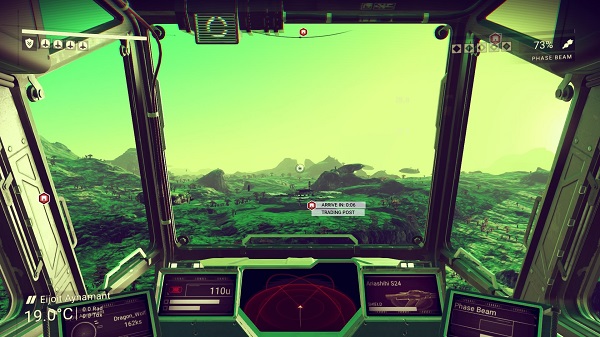
Once you’re done shooting down marauders, you can dock into the space station and prepare for the largest number of aliens you’ll see in No Man’s Sky. Except, you can’t actually see them. Space stations in No Man’s Sky are a hotbed of alien life and the busiest places you are likely to find, but nobody ever actually leaves their ship. While you can walk up to other ships and open a conversation window with a Pilot, it’s disappointing that they never actually come out and walk around the place. Generally, there might be a single alien that can be seen in a space station and sometimes none at all. You’re able to trade with every pilot that lands in a space station, including making an offer and purchasing their ship, but there is little to no conversation beyond this. While there is obviously a language barrier, it would have been interesting to see conversations longer than a single sentence, especially considering all conversations are text with no voice acting.
Once you’re done with a solar system, and assuming you have enough fuel in your warp drive, it’s time to warp to the next solar system. Bringing up the warp chart gives you a glimpse into the truly impressive size of No Man’s Sky’s galaxy, with every single star you see being one you can fly to. There are a number of direct paths you can follow, including a pre-plotted course to the center of the galaxy and another that follows the mysterious Atlas narrative line, but you also have the option to turn these off and simply warp to any solar system that is in reach. Flying around in space and warping from star to star is an experience unlike anything I have played before and can be awe inspiring, but in reality it is the smallest part of No Man’s Sky. Coming out of warp to the view of multiple planets and a sun in front of you is beautiful and gives you a real sense of the vast nature of No Man’s Sky and continues as your fly through the atmosphere down to a planet’s landmass.
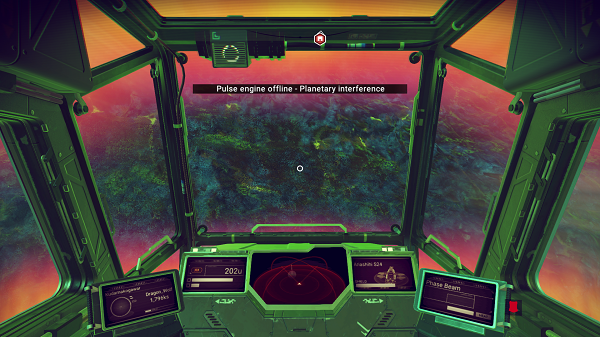
The art style of No Man’s Sky is colourful, stylised and absolutely beautiful to look at, but it isn’t always perfect up close. Vistas are incredible, but up close to grass and similarly thinner geometry’s jagged edges become clearly noticeable. There are also issues when mining for resources, with square blocks of colour appearing and thin spindly polygonal shapes appearing in the sky as you blast as the rocks around them.
Technical problems begin to pile up as you move to more densely populated areas of space. While the framerate is generally fine, there are odd stutters every once in a while when travelling on foot where the game pauses for a second or so and then continues again. These also commonly occur after saving for the first time when discovering a way point, but not when you save subsequent times at the same waypoint. There is also a more concerning and serious issue with hard crashes. In my household, across 3 separate games and consoles, we experienced 7 hard crashes in just over 24 hours. Hard crashes are never a good thing, but as No Man’s Sky only autosaves when exiting your ship, this can be a serious issue for players that prefer to spend large amounts of time on foot. If you’re not manually saving at way points you could possibly lose a good chunk of gameplay due to these crashes.
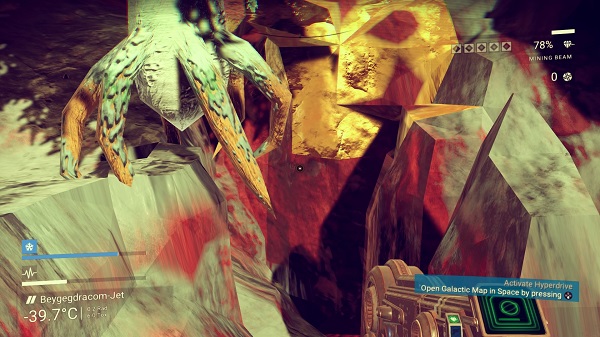
Overall, my experience with No Man’s Sky has been a positive one, but I don’t believe it is quite the experience that was promised when the game was announced back in 2013. Discovery was pushed as a large pillar of No Man’s Sky, however actually doing that is highly time consuming and relatively unrewarding in-game. Trading was another pillar pushed for No Man’s Sky¸ but without a mapping system it can become hard to find your way back to a previously visited system. While flight is simple, you won’t spend much time in the cockpit, as your ship can’t interact with planets. The variety within the procedural engine isn’t what I had hoped for, with frequently reused parts, and the weather system is an easily avoidable threat that feels half-baked. In my eyes, the language system is the one part of No Man’s Sky that truly shines and cannot be faulted at all.
By no means is No Man’s Sky a bad game, but it just isn’t an amazing one. That a team of 10 people could create the vast experience they have is an incredible feat and one that should never be downplayed, but I almost wish they hadn’t been so intent on creating such a giant experience. The right ideas are there, but many of them almost feel like they weren’t fully completed by the time the game launched. The current release is an excellent platform to start from and I have no doubt that with further content and updates it will gradually become the experience that many wanted when it was announced. There is definitely much to love in No Man’s Sky and it will be one of the moist divisive releases of the past few years, but my suggestion is to hold off on purchasing it until more content is released for it.
Language system is amazing
Mining feels incredibly satisfying
Space combat and controls are accessible
Hard crashes and stuttering
Weather system is easily avoidable
Discovery system is cumbersome and rewards are paltry
Procedural generation repeats parts often

